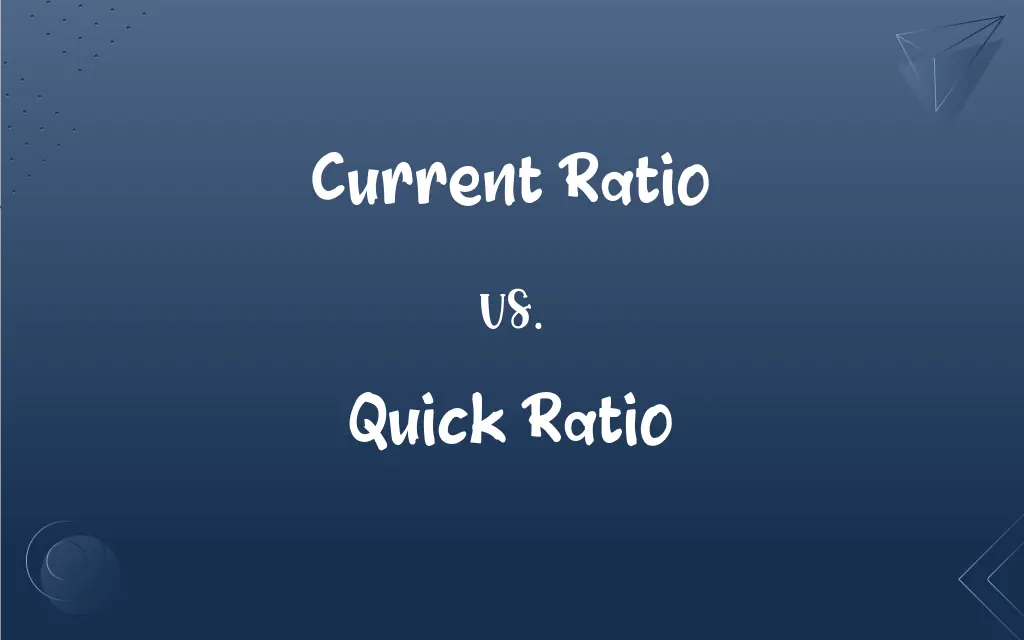Current Ratio vs. Quick Ratio: What's the Difference?
Edited by Janet White || By Harlon Moss || Updated on October 27, 2023
Current ratio measures a company's ability to cover short-term liabilities with all short-term assets; quick ratio does the same but excludes inventory and prepayments.

Key Differences
Current ratio is a fundamental liquidity metric used to gauge a company's ability to settle its short-term obligations with its short-term assets. It is calculated by dividing a company's current assets by its current liabilities. The resulting value provides insight into the financial health of a firm. A ratio of more than one implies that the company has more assets than liabilities and is typically seen as being financially secure. On the other hand, quick ratio, often termed the acid-test ratio, serves a similar purpose but offers a more stringent assessment.
Where the current ratio takes into account all current assets, the quick ratio excludes certain elements like inventory and some prepaid expenses. This is because the quick ratio focuses on the most liquid assets - those assets which can be quickly converted into cash. By excluding inventories, the quick ratio recognizes that, in times of financial distress, inventory may not be easily liquidated at its full value.
For companies with substantial inventory, there can be a vast difference between current ratio and quick ratio values. If a company's current ratio is considerably higher than its quick ratio, it may indicate heavy reliance on inventory for liquidity. This might be a red flag for certain industries where inventory can become obsolete quickly.
In essence, both the current ratio and quick ratio are tools that investors, creditors, and other stakeholders use to assess a company's liquidity position. While the current ratio offers a broader view of a company's short-term assets relative to its short-term liabilities, the quick ratio provides a more conservative view by focusing on the most liquid assets.
Comparison Chart
Definition
Measures short-term liquidity by comparing all current assets to current liabilities.
Assesses liquidity by comparing most liquid assets (excluding inventory) to current liabilities.
ADVERTISEMENT
Components Included
All current assets
Excludes inventory & certain prepayments
Indication
General liquidity position
Immediate liquidity position
Formula
Current Assets / Current Liabilities
(Current Assets - Inventory - Prepayments) / Current Liabilities
Sensitivity
Less conservative
More conservative
Current Ratio and Quick Ratio Definitions
Current Ratio
A liquidity ratio that gauges the financial health of a company by considering all its current assets.
Creditors often prefer businesses with a higher current ratio, as it suggests greater liquidity.
ADVERTISEMENT
Quick Ratio
An indicator providing a snapshot of a company's short-term liquidity without counting inventory.
Investors often consider the quick ratio for a more conservative assessment of liquidity.
Current Ratio
A metric evaluating a company's ability to cover its short-term debts with its short-term assets.
If a company has $1 million in current assets and $500,000 in current liabilities, its current ratio is 2.
Quick Ratio
Also known as the acid-test ratio, it gauges liquidity by excluding assets that aren't easily convertible to cash.
A low quick ratio might indicate a high dependence on inventory or other less-liquid assets.
Current Ratio
The proportion between a firm's available short-term resources and its short-term obligations.
A current ratio below 1 might indicate the company could struggle to meet its short-term obligations.
Quick Ratio
A stringent measure of a firm's immediate financial health by focusing on cash, marketable securities, and receivables.
Businesses in industries with fast-moving inventory might still have a healthy quick ratio despite excluding inventory.
Current Ratio
An indicator of a company's capacity to meet its short-term financial commitments.
Companies in the retail sector often have a fluctuating current ratio due to seasonal inventory changes.
Quick Ratio
A ratio that determines a company's capacity to pay off its current liabilities without relying on inventory sales.
Even if a company has a high current ratio, a significantly lower quick ratio could be a concern.
Current Ratio
A measure comparing all assets that can be liquidated within a year to liabilities due within the same timeframe.
Analyzing the trend of a company's current ratio over time can offer insights into its financial stability.
Quick Ratio
A financial metric assessing a firm's capability to cover its short-term liabilities with its most liquid assets.
A quick ratio of 1 or higher often suggests that a company can pay off its immediate debts without selling inventory.
FAQs
How is the quick ratio different from the current ratio?
The quick ratio assesses liquidity by excluding inventory and certain prepayments, making it more stringent than the current ratio.
Can a company have a high current ratio and a low quick ratio?
Yes, if a company has a significant amount of its current assets in inventory, it could have a high current ratio but a lower quick ratio.
Is a higher current ratio always better?
Not necessarily. An excessively high current ratio might indicate inefficient use of resources, while a very low ratio could signal liquidity concerns.
In which scenarios would the quick ratio be particularly important?
The quick ratio becomes crucial in industries where inventory isn't easily liquidated or for companies facing immediate financial challenges.
Why is the quick ratio called the "acid-test" ratio?
The quick ratio provides a more immediate and conservative assessment of a firm's liquidity, much like an "acid test" in chemistry that offers clear and quick results.
Why might a creditor prefer to look at the current ratio over the quick ratio?
A creditor might view the current ratio for a broader perspective on a company's overall short-term financial health.
Why might a company with high sales still have a low current ratio?
High sales don't always mean high liquidity. The company might have significant short-term debts or slow inventory turnover affecting the current ratio.
If a company's quick ratio is increasing over time, what might that indicate?
An increasing quick ratio could suggest improving immediate liquidity or decreasing reliance on inventory and less liquid assets.
Are marketable securities considered in the current ratio?
Yes, marketable securities, being short-term investments, are included in the current ratio.
What does the current ratio measure?
The current ratio measures a company's ability to cover its short-term liabilities with its short-term assets.
How are receivables treated in the quick ratio?
Receivables are included in the quick ratio as they are considered liquid assets that can be quickly converted to cash.
How does inventory impact the current ratio and quick ratio?
Inventory is included in the current ratio, affecting its value, but is excluded from the quick ratio to provide a more conservative liquidity assessment.
Can industries with fast inventory turnover have a decent quick ratio?
Yes, industries with quick inventory turnover might still maintain a healthy quick ratio despite the exclusion of inventory.
How often should businesses evaluate their quick ratio?
Regularly, especially in dynamic environments or when facing significant financial decisions.
Which ratio is more conservative: current ratio or quick ratio?
The quick ratio is more conservative as it only considers the most liquid assets.
What assets are typically excluded in the quick ratio?
Inventory and certain prepayments are typically excluded when calculating the quick ratio.
Can changes in the current and quick ratios indicate operational efficiency shifts?
Yes, significant changes in these ratios can signal shifts in operational efficiency, inventory management, or financial health.
Is the current ratio an absolute measure of financial health?
No, the current ratio offers a relative perspective, and its interpretation might vary based on industry standards and company specifics.
Can both ratios be used together for financial analysis?
Yes, using both can provide a comprehensive view of a company's short-term liquidity position.
What does a quick ratio of less than 1 indicate?
A quick ratio below 1 suggests the company might not be able to pay its short-term obligations if they came due immediately without selling inventory.
About Author
Written by
Harlon MossHarlon is a seasoned quality moderator and accomplished content writer for Difference Wiki. An alumnus of the prestigious University of California, he earned his degree in Computer Science. Leveraging his academic background, Harlon brings a meticulous and informed perspective to his work, ensuring content accuracy and excellence.
Edited by
Janet WhiteJanet White has been an esteemed writer and blogger for Difference Wiki. Holding a Master's degree in Science and Medical Journalism from the prestigious Boston University, she has consistently demonstrated her expertise and passion for her field. When she's not immersed in her work, Janet relishes her time exercising, delving into a good book, and cherishing moments with friends and family.































































